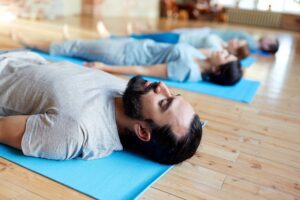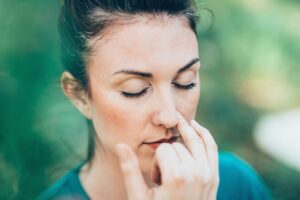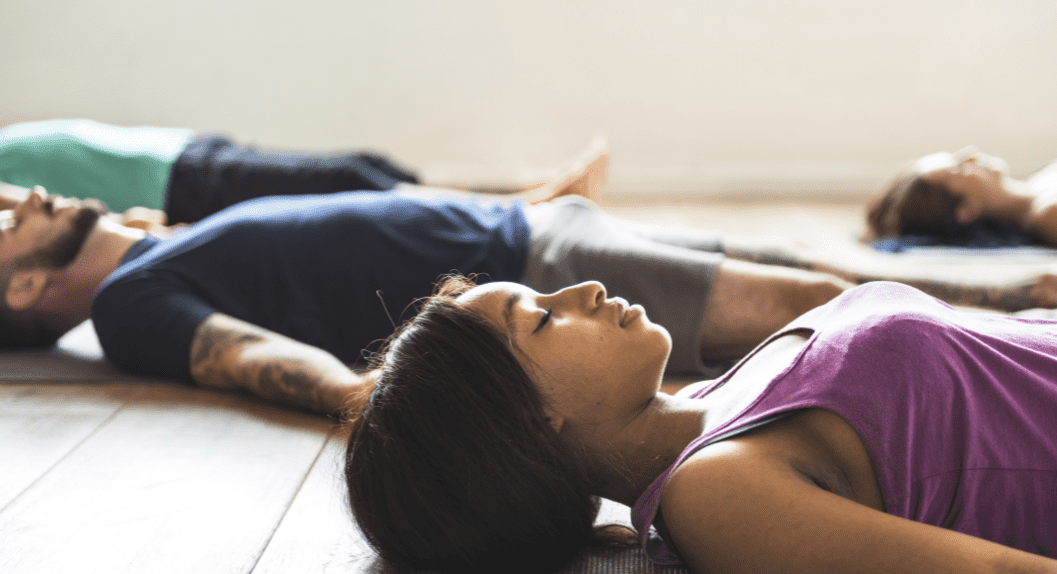Application of Yoga Therapy into Healthcare
Dilip Sarkar, MD, FACS, CAP, C-IAYT
SUMMARY/ABSTRACT:
Yoga Therapy is the adaptation of the Yoga practices for patients with various chronic dis-eases. Yoga is a stepwise practice for self-realization. During the practice a person also develops some health benefits, which can be used as adjuvant therapy for chronic dis-eases. A daily practice of Yoga Therapy will cause Rogir Chikitsā (treatment of dis-ease), secondary prevention or therapeutic medicine, and Swāsthya Rakshma (maintenance of health), primary prevention or preventive medicine. It also helps in the rehabilitation of a dis-ease with better management of the dis-ease, less pharmaceutical support, and better quality of life. In addition to bringing back our health, the practice of Yoga Therapy causes wellness in all realms: physical-mental-spiritual. Physical wellness provides strength and stamina, but mental and spiritual wellness provides healing. As most chronic endogenous dis-eases manifest with an acute onset, standard evidence-based Western Medical therapy should begin at that time, along with personal lifestyle modification through Yoga Therapy. Yoga Therapy will gradually improve one’s underlying condition and the chronic use of medications can be slowly withdrawn to reduce negative side effects, resulting in improved, medication-free, dis-ease free healthy living.

Yoga activates the relaxation response.
ARTICLE:
Yoga has evolved as one of the most reliable, authentic, and efficient health care systems available in society today. Most people believe that daily practice of Yoga and maintenance of a yogic lifestyle produces better health benefits than does regular exercise. This is due to yogic activation of the relaxation response and parasympathetic tone. These yogic health benefits are useful as therapy for stress-related high sympathetic tone causing chronic lifestyle-related dis-eases like truncal obesity, diabetes, hypertension, heart disease, dyslipidemia, chronic lower back pain, arthritis, and asthma.
I. The State of Yoga Therapy Today
The expanding field of Yoga Therapy includes a wide variety of practitioners and organizations. It has become part of Integrative Medicine, another sub-specialty of the Internal Medicine department. Fifteen years back, 3 out of 140 medical schools in the U.S. had a department of Integrative Medicine; now about 100 medical schools have the sub-specialty. About 65 medical school teaching programs have fellowships in Integrative Medicine, and 26 of them have been approved by the American Board of Integrative Medicine. Today, tertiary medical centers like the renowned Cleveland Clinic are using Yoga as therapy in their Lifestyle 180 Program by offering Yoga classes daily to their patients. Most of the health care centers in the U.S. have incorporated Yoga Therapy in their treatment protocol. In 1998, the National Institutes of Health (NIH) established a full-strength federal agency, the National Center for Complementary and Alternative Medicine (NCCAM), and included Yoga as a part of CAM treatment. In December of 2014, Congress changed the name from NCCAM to NCCIH (National Center for Complementary and Integrative Health) because the Yoga practice outcome is the maintenance of health. The NIH website currently lists 324 ongoing clinical trials for Yoga as therapy, all funded by NIH grants. On May 19-23, 2008, the NIH premiered its first annual Yoga Week, highlighting the science, research, and practice of Yoga. The PubMed (U.S. National Library of Medicine) website lists over 4,500 journal citations about Yoga Therapy. The International Association of Yoga Therapists (IAYT), a non-profit organization, spans a twenty-nine year history and serves as a professional organization for over 6,000 Yoga therapists from 50 countries. The IAYT started self-monitoring of the Yoga Therapists, with introduction of standards in 2012, accreditation of Yoga Therapy schools in 2014, and certification of Yoga Therapists in 2016. Today there are around 40 accredited Yoga Therapy schools out of over 200 member schools and around 3,700 certified Yoga Therapists. IAYT publishes a peer-reviewed annual journal, International Journal of Yoga Therapy, and a tri-annual publication, Yoga Therapy Today. In 2007, Dr. Timothy McCall published the first Yoga Therapy book, Yoga as Medicine, with references of health conditions benefited by Yoga. Recently multiple textbooks have been published for Yoga Therapy students, like Yoga Therapy and Integrative Medicine, The Principles and Practice of Yoga in Health Care, and Research Based Perspectives on the Psychophysiology of Yoga. My book Yoga Therapy, Ayurveda, and Western Medicine: A Healthy Convergence, published as textbook in 2017, was very well received by the Yoga Therapy and Ayurveda Yoga Therapy community. Large number of books were sold within a few months, and another publisher started marketing the book. There is no other book that addresses these three healing modalities together. A recent survey in 2016 by Yoga Journal and Yoga Alliance, a non-profit group with 95,000 members in 145 countries that maintains a registry of Yoga teachers and schools, found that 36.7 million Americans are practicing Yoga, and 80 million say they will try Yoga in the future. Yoga is a 16 billion-dollar industry. An August 2009 survey conducted by the Pew Forum on Religion and Public Life found that 23% of Americans believe Yoga to be “a spiritual practice with health benefits.” In the United States, Yoga is visible on the covers of Time and Newsweek magazines, in iPhone applications, and in the advertisements of McDonald’s, Wal-Mart, various hotel chains, and different companies. Video game maker Nintendo brings Yoga into people’s homes with their popular Wii Fit program to improve balance and flexibility.
Western Medicine defines health as the absence of dis-ease, whereas in yogic tradition dis-ease is defined as the absence of vibrant health. Yoga Therapy is not dis-ease-specific, but rather Yoga’s therapeutic benefit is derived from a general target to maintain good health.
II. The Philosophy of Yoga Therapy
The term “Yoga” is derived from the Sanskrit word yuj, meaning yoke or union, specifically the union of body, mind, and spirit. Yoga views the body as the physiological function of different systems that is treated by allopathic medicine, the mind as the psychology and perception through the five senses treated by psychiatry, and the spirit as the impact of the beliefs and philosophy on our physical body and treated by integrative medicine. These three units can be analogized to cyber-language terms, where the body is the hardware, the mind is the software, and the spirit is the programmer. The mind (the software) controls the physical body (the hardware). By controlling the mind through yogic practice, one can control the physical body and its ailments. In yogic tradition, health is defined as a balance between body, mind, and spirit. By uniting body, mind, and spirit one achieves health and in turn resists dis-ease. Western Medicine defines health as the absence of dis-ease, whereas in yogic tradition dis-ease is defined as the absence of vibrant health. Yoga Therapy is not dis-ease-specific, but rather Yoga’s therapeutic benefit is derived from a general target to maintain good health. Yoga Therapy simultaneously treats a dis-ease (rogir chikitsa) and maintains one’s health (swastha rakhsa). This maintenance of the health or personalized lifestyle change is used in Western Medicine as adjuvant therapy.
Yoga Therapy is the process of empowering individuals to progress towards improved health and well-being through the application of the philosophy and practice of Yoga. This yogic philosophy is outlined in the Yoga Sutras of Patanjali, a foundational ancient treatise that describes Yoga as “the cessation of the fluctuations of the mind” (yoga chitta vritti nirodha). The practice of Yoga is Patanjali Ashtanga Yoga (eight limbed Yoga), a systemic practice of eight limbs to attain the transformative union of body, mind, and spirit in the eighth limb, called samadhi. The first two limbs, yama (social disciplines) and niyama (personal disciplines), control the attitude and the mind. The third limb, asana, is the relaxed external and internal alignment of the physical body while the fourth limb, pranayam, controls one’s breathing to transform the mind. Pratyahara, the fifth limb, and controls the five senses and unites them with the mind. The sixth limb, dharana, advocates single-pointed focus on one object to avoid other thoughts in order for one’s prana, or life force, to unite with the mind. The last practice (the seventh limb) is dhyana, or meditation, where a thoughtless mind connects to our individual spirit or soul.

Pranayama (breath control) is an important part of Yoga Therapy.
III. Application of Yoga Therapy to the Individual Through Asanas, Pranayam and Meditation
Yoga Therapy is not evidence-based medicine, but rather, practice-based evidence. A standard template or one-size-fits-all strategy does not work for Yoga; it is individualized to each person and requires personalized lifestyle changes. Studies have shown lifestyle changes through Yoga can be better than drugs in helping people deal with various ailments. Yoga Therapy is a strong medicine, but it is also a very slow-working medicine. It is very addictive, transformative, and synergistic with other therapies and cleanses the mind and body. The therapeutic effects are achieved through a relaxation response that activates the body’s parasympathetic nervous system which calms the mind and body and also aids in digestion. The relaxation response causes a slower heart rate, decreased blood pressure, slow and steady respiration, improved vital capacity, and longer breath-holding power.
Yoga poses, or asanas, go through three stages. Initially, the muscles contract during the arambha stage, or the beginning. By staying in the pose for an extended period of time with the eyes closed and continuous yogic breathing (effortless exhalation time that is close to double the inhalation time), the muscle contractions become steady (sthiti). During the final stage of surrender (visharjana), there is profound relaxation of the muscles and ligaments. This relaxation produces external and internal alignment, relaxation of the blood vessels of vital organs with proper perfusion, and proper physiological function of the systems. Asanas also systematically place pressure on the internal organs with massage and toning. The daily practice of asanas gives the physical body a proper shape, making it flexible and energetic.
The most important component of Yoga Therapy is pranayam (controlled breathing). Normally, the total lung capacity in one’s body is around 5.5 liters with 1.5 liters of residual volume. This gives our lungs about 4 liters of vital capacity, but the typical tidal volume, or volume of air displaced between normal inhalation and exhalation without extra effort, is only 500 milliliters in most people. That leaves 3.5 liters of carbon dioxide and other toxic gases sitting in the lungs. By deep breathing and through prolonging the exhalation through pranayam, one removes these toxic gases from the lungs and brings more oxygen to the tissue. This oxygen then combines with glucose (the end product of metabolism to form carbon dioxide and water) and releases ATP, the energy for our bodies. This aerobic glycolysis produces energy that acts as a dis-ease-fighting agent. On the other hand, when oxygen is not adequate, the glucose metabolism goes through anaerobic glycolysis, producing lactic acid and pain-producing substances, which are pre-cursors to lifestyle-related dis-eases.
Inhalation is sympathetic and exhalation is parasympathetic. By prolonging exhalation more than inhalation, the parasympathetic nerve activation described above takes place. Yoga philosophy believes that by controlled breathing the life force, or prana, flows freely throughout the body. This prana is the healing power and medicine vital to one’s health and well-being. Bringing more oxygen to the tissue, massaging internal organs, and keeping the mind steady through pranayam achieves prana. For a good outcome of pranayam, it should be done with vidhi (method), samaya (timing), sankalpa (determination), and siddhi (surrender).
While genetic predisposition may be a “loaded gun” for these chronic dis-eases, the “trigger” to the gun is one’s lifestyle. By controlling one’s lifestyle through Yoga practice, one can achieve primary prevention of the dis-ease by preventing the genetic expression from ever taking place.
IV. Scientific and Medical Observations of Yoga Therapy
The therapeutic effect of Yoga is through psycho-neuro-endocrinology. The limbic system of the brain (psycho) is the site of our emotions and mind. The two nuclei, the amygdala and hippocampus, become activated when the mind is controlled through Yoga and the five senses. They send a signal to the hypothalamus (neuro) through neurotransmitters. The hypothalamus then sends a signal to the autonomic nervous system and the pituitary gland (endocrinology). Through a negative feedback cycle, the pituitary gland corrects altered hormonal homeostasis by fixing the system’s abnormalities, not merely its symptoms. The benefits of Yoga are seen even at the cellular level. Every cell contains an infinite wealth of intelligence, discipline, and consciousness. In a dis-eased state, these functions become altered. Yoga brings back the cell functions and promises great hope in curing dis-eases such as cancer by bringing back the intelligence, discipline, and consciousness to cancerous cells.
Most chronic diseases like diabetes, hypertension, and heart disease have an element of genetic predisposition. In order for a dis-ease to manifest, the genetic predisposition has to convert to a genetic expression. This conversion is done through a person’s lifestyle choices called epigenetics, which are completely within one’s control. Therefore, while genetic predisposition may be a “loaded gun” for these chronic dis-eases, the “trigger” to the gun is one’s lifestyle. By controlling one’s lifestyle through Yoga practice, one can achieve primary prevention of the dis-ease by preventing the genetic expression from ever taking place.
In the case of clinical dis-eases, where genetic expression has already taken place, Yoga Therapy can be initiated after the usual and customary treatments to cause genetic suppression, secondary prevention to stop progression, or even to completely reverse the dis-ease. Yoga Therapy can also be used as rehabilitation of a dis-ease by leading to better management of the dis-ease, less pharmaceutical support, and better quality of life. In some cases, Yoga Therapy has been reported as a cure for chronic dis-eases. During hospice care of a terminal patient, pranayam (controlled breathing) can be used to prevent shortness of breath and air hunger. Finally, pregnant women who practice yoga before and during pregnancy require less epidural, pitressin drip, and cesarean sections during delivery than women who do not practice Yoga.
V. Conclusion
In conclusion, Yoga Therapy can be used in Western Medicine to treat chronic dis-eases. Because most chronic endogenous dis-eases present with acute onset, standard evidence-based conventional therapy should be started at that point, along with personal lifestyle modifications through Yoga Therapy. Over time, Yoga Therapy through asanas, pranayam and meditation will improve one’s underlying condition and chronic dependence on medications can be slowly withdrawn, resulting in reduced side effects and improved, dis-ease free, medication-free healthy living.
Select General References
Aurobindo, Sri. The Synthesis of Yoga. Pondicherry, India: Sri Aurobindo Ashram Publication, 1984.
Balkrishna, Acharya. Yog: In Synergy with Medical Science. Haridwar, India: Divya Prakashan, 2010.
Benson, Herbert. The Relaxation Response. New York: Harper Collins, 1975.
Bhishagratna, Kaviraj Kunja Lal. Sushruta Samhita (with English translation). Varanasi, India: Chowkhamba Sanskrit Series Office, 1998.
Chopra, Deepak, and David Simon. Grow Younger, Live Longer: Ten Steps to Reverse Aging. New York: Harmony Books, 2001.
Frawley, David. Ayurvedic Healing: A Comprehensive Guide. Twin Lakes, WI: Lotus Press, 1989.
Hirschi, Gertrud. Mudras: Yoga in Your Hands. San Francisco, CA: Weiser, 2000.
Iyengar, B. K. S. Light on Pranayama: The Yogic Art of Breathing. New York: Crossroad Publishing Company, 1985.
Iyengar, B. K. S. Light on Yoga. New York: Schocken Books, 1966.
Iyengar, B. K. S. Yoga: The Path to Holistic Health. London: DK Publishing, 2001.
Khalsa, Dharma Singh, and Cameron Stauth. Meditation as Medicine: Activate the Power of Your Natural Healing Force. New York: Atria Books, 2002.
Khalsa, Sat Bir, Lorenzo Cohen, Timothy McCall, and Shirley Telles. The Principles and Practice of Yoga in Health Care. Edinburgh: Handspring Publishing, 2016.
Lad, Vasant. Secrets of the Pulse: The Ancient Art of Ayurvedic Pulse Diagnosis. Albuquerque, NM: Ayurvedic Press, 1996.
Lad, Vasant. Textbook of Ayurveda. Albuquerque, NM: Ayurvedic Press, 2001.
Lad, Vasant, and Anisha Durve. Marma Points of Ayurveda. Albuquerque, NM: Ayurvedic Press, 2008.
McCall, Timothy. Yoga as Medicine: The Yogic Prescription for Health and Healing. New York: Bantam, 2007.
Moyers, Bill. Healing and the Mind. New York: Doubleday, 1993.
Muktibodhananda, Swami. Hatha Yoga Pradipika. Jharkland, India: Bihar School of Yoga, 1998.
Murthy, K. R. Srikantha. Vaghbhata’s Astanga Hrdayam (with English translation). Varanasi, India: Krishnadas Academy, 1998.
Ornish, Dean. Dr. Dean Ornish’s Program for Reversing Heart Disease. New York: Ballantine, 1992.
Payne, Larry, et al. Yoga Therapy and Integrative Medicine: Where Ancient Science Meets Modern Medicine. Nashville, TN: Basic Health Publications, Inc., 2015.
Saraswati, Swami Satyananda. Asana Pranayama Mudra Bandha. Bihar, India: Yoga Publications Trust, 1969.
Sarkar, Dilip. Yoga Therapy, Ayurveda, and Western Medicine: A healthy Convergence. Raleigh, North Carolina: Lulu Press Inc. 2017
Satchidananda, Swami. The Yoga Sutras of Patanjali: Commentary on the Raja Yoga Sutras. Buckingham, VA: Integral Yoga Publications, 1990.
Sharma, R. K., and Bhagwan Dash. Charaka Samhita (with English translation). Varanasi, India: Chowkhamba Sanskrit Series Office, 1999.
Taksha Yoga Therapy for Health and Healing, for Body Mind and Spirit, presented by Dr. Dilip Sarkar. Dir. Vibhaa Vermani. DVD. TakshaShila: 2009. Description at: https://www.dilipsarkar.com/yoga-therapy-dvd/ Available for purchase at: https://deepakonline.com/product_info.php?products_id=84&osCsid=2on8qr136j4gk0idl2691hklp2
Taksha Yoga Therapy for Health and Healing: A Daily Practice, presented by Dr. Dilip Sarkar. Dir. Josh Fowler. DVD. TakshaShila: 2015. Description at: https://www.dilipsarkar.com/new-yoga-therapy-dvd/ Available for purchase at: https://deepakonline.com/product_info.php?cPath=22_26&products_id=105
Amazon link to buy DVD: https://www.amazon.com/Taksha-Yoga-Therapy-Heath-Healing/dp/B01DX0NCE4?ie=UTF8&keywords=DVD%20Dilip%20Sarkar%20Yoga&qid=1461856632&ref_=sr_1_1&sr=8-1
Ayurvedic Institute: https://www.ayurveda.com
Bihar Yoga: https://www.biharyoga.net
Himalayan Institute: https://www.himalayaninstitute.org
International Association of Yoga Therapists (IAYT): https://www.iayt.org
International Journal of Yoga – https://www.ijoy.org.in
International Journal of Yoga Therapy (IJYT): https://www.iayt.org/?page=IJYTCurrent
Kaivalyadhama Yoga Institute: https://www.kdham.com
Kripalu Center for Yoga & Health: https://kripalu.org
Mount Madonna Institute: https://www.mountmadonnainstitute.org
National Ayurvedic Medical Association (NAMA): https://www.ayurveda-nama.org
National Center for Complementary and Integrative Health (NCCIH): https://nccih.nih.gov
National Institutes of Health (NIH): https://www.nih.gov
Omega Institute for Holistic Studies: https://www.eomega.org
Patanjali Yog Peeth: https://www.divyayoga.com
PubMed.gov (U.S. National Library of Medicine, National Institutes of Health): https://www.ncbi.nlm.nih.gov/pubmed
Swami Vivekananda Yoga Anusandhana Samsthana (S-VYASA) University: https://www.svyasa.org
Yoga Alliance: https://www.yogaalliance.org
Yoga Institute: https://theyogainstitute.org
Yogaville Satchidananda Ashram: https://www.yogaville.org
Bagchi, B. K., and M. A. Wenger. 1957. “Electro-physiological Correlates of Some Yoga Exercises.” Electroencephalography and Clinical Neurophysiology, Suppl 7: 132–149.
Anand, B.K., et al. 1961. “Some Aspects of Electroencephalographic Studies in Yogis.” Electroencephalography and Clinical Neurophysiology 13: 452–456.
Ryan, A.J. 1962. “Be Young with Yoga.” Journal of the American Medical Association 182 (11): 1138.
Corrigan, G.E. 1969. “Fatal Air Embolism After Yoga Breathing Exercise.” Journal of the American Medical Association 210 (10): 1923.
Chusid, J. 1971. “Yoga Foot Drop.” Journal of the American Medical Association 217 (6): 827–828.
Pratap, V. 1971. “Scientific Studies on Yoga.” Yoga Mimamsa 13: 1–18.
Bhole, M. V., and P. V. Karambelkar. 1972. “Yoga Practices in Relation to Therapeutics.” Yoga Mimamsa 14: 27–34.
Chusid, J. 1972. “Yoga Power.” Journal of the American Medical Association 219 (3): 385.
Udupa, K. N., and R. H. Singh. 1972. “The Scientific Basis of Yoga.” Journal of the American Medical Association 220 (10): 1365.
Patel, C.H., et al. 1973. “Yoga and Bio-Feedback in the Management of Hypertension.” Lancet 302 (7837): 1053–1055.
Benson, H., et al. 1974. “The Relaxation Response.” Psychiatry 37.
Patel, C.H., et al. 1975. “Yoga and Bio-Feedback in the Management of Hypertension.” Lancet 306 (7925): 93–95.
Vinekar, S.L. 1976. “Scientific Basis of Yoga.” Yoga Mimamsa 18: 89–97.
Nagaratna, R., and H. R. Nagendra. 1985. “Yoga for Bronchial Asthma: A Controlled Study.” British Medical Journal (Clin Res Ed) 291 (6502): 1077.
Ornish, D., et al. 1990. “Can Lifestyle Changes Reverse Coronary Heart Disease? The Lifestyle Heart Trial.” Lancet 336 (8708): 129–133.
Anand, B. K. 1991. “Yoga and Medical Sciences.” Indian J Physiol Pharmacol 35: 84–87.
Conny, M., et al. 1993. “Heart Rate Variability.” Annals of Internal Medicine 118 (6): 436–447.
Ornish, D., et al. 1995. “Changes in Myocardial Perfusion Abnormalities by Positron Emission Tomography After Long Term Intensive Risk Factor Modification.” Journal of the American Medical Association 274: 894–901.
Telles, S., et al. 1996. “Physiological Measures of Right Nostril Breathing.” J Altern Complement Med 2 (4): 479–84.
Bernardi, L., et al. 1998. “Effect of Breathing Rate on Oxygen Saturation and Exercise Performance in Chronic Heart Failure.” Lancet 351 (9112): 1308–1311.
Garfinkel, M. S., et al. 1998. “Yoga Based Intervention for Carpal Tunnel Syndrome.” Journal of American Medical Association.
Ornish, D., et al. 1998. “Intensive Lifestyle Changes for Reversal of Coronary Heart Disease.” Journal of the American Medical Association 280 (23).
Manchanda, S. C., et al. 2000. “Retardation of Coronary Atherosclerosis with Yoga Lifestyle Intervention.” Journal of the Association of Physicians of India 48 (7): 687–694.
Bernardi, L., et al. 2001. “Slow Breathing Reduces Chemoreflex Response to Hypoxia and Hypercapnia, and Increases Baroreflex Sensitivity.” Journal of Hypertension 19 (12): 2221–2229.
Bernardi, L., et al. 2005. “Slow Breathing Improves Arterial Baroreflex Sensitivity and Decreases Blood Pressure in Essential Hypertension.” Hypertension.
Jovanov, E. 2005. “On Spectral Analysis of Heart Rate Variability during Very Slow Yogic Breathing.” Conf Proc IEEE Eng Med Biol Soc. 3: 2467–2470.
Lazar, S. W., et al. 2005. “Meditation Experience is Associated with Increased Cortical Thickness.” Neuroreport 16: 1893–1897.
Sherman, K. J., and D. C. Cherkin. 2005. “Comparing Yoga, Exercise and a Self-Care Book for Chronic Low Back Pain: A Randomized Controlled Trial.” Annals of Internal Medicine 143 (12).
Cohen, D., and R. R. Townsend. 2007. “Yoga and Hypertension.” Journal of Clinical Hypertension 9 (10).
Innes, K. E., and H. K. Vincent. 2007. “The Influence of Yoga-Based Programs on Risk Profiles in Adults with Type 2 Diabetes Mellitus: A Systematic Review.” Evid Based Complement Alternat Med. 4 (4): 469–486.
Raman, G., et al. 2007. “Positive Impact of Yoga and Pranayam on Obesity, Hypertension, Blood Sugar and Cholesterol: A Pilot Assessment.” Journal of Alternative and Complementary Medicine 13 (10): 1056–1058.
Streeter, C. C., et al. 2007. “Yoga Asana Sessions Increase Brain GABA Levels: A Pilot Study.” Journal of Alternative and Complementary Medicine 13: 419–426.
Tang, Y., et al. 2007. “Short-term Meditation Training Improves Attention and Self-Regulation.” Proceedings of the National Academy of Sciences 104: 17152–17156.
Ornish, D., et al. 2008. “Changes in Prostate Gene Expression in Men Undergoing an Intensive Nutrition and Lifestyle Intervention.” Proceedings of the National Academy of Science, published online.
Alexander, G. K., et al. 2009. “Contextualizing the Effects of Yoga Therapy on Diabetes Management—A Review of the Social Determinants of Physical Activity.” NIH Public Access Author Manuscript, Fam Community Health, available online.
Birdee, G. S., et al. 2009. “Clinical Applications of Yoga for Pediatric Population: A Systematic Review.” Academic Pediatrics 9 (4).
Joshi, M., and S. Telles. 2009. “A Nonrandomized Non-Naive Comparative Study of the Effects of Kapalabhati and Breath Awareness on Event-Related Potentials in Trained Yoga Practitioners.” J Altern Complement Med. 15 (3): 281–285.
Pramanik, T., et al. 2009. “Immediate Effect of Slow Pace Bhastrika Pranayama on Blood Pressure and Heart Rate.” J Altern Complement Med. 15 (3): 293–295.
Williams, K., et al. 2009. “Evaluation of the Effectiveness and Efficacy of Iyengar Yoga Therapy on Chronic Low Back Pain.” Spine 34 (19): 2066–2076.
Kumar, S., et al. 2010. “Meditation on OM: Relevance from Ancient Texts and Contemporary Science.” Int J Yoga 3 (1): 2–5.
Streeter, C. C., et al. 2010. “Effects of Yoga Versus Walking on Mood, Anxiety, and Brain GABA Levels: A Randomized Controlled MRS Study.” J Altern Complement Med. 16 (11): 1145–1152.
Telles, S., et al. 2010. “Post-traumatic Stress Symptoms and Heart Rate Variability in Bihar Flood Survivors Following Yoga: A Randomized Controlled Study.” BMC Psychiatry 10 (18).
Vijaypal, A., et al. 2010. “Efficacy of Bolus Lukewarm Saline and Yoga Postures as Colonoscopy Preparation: A Pilot Study.” Journal of Alternative and Complementary Medicine 16 (12): 1269–1277.
Gangadhar, B. N. et.al. 2011. “Neurohemodynamic Correlates of ‘OM’ Chanting: A Pilot Functional Magnetic Resonance Imaging Study.” International Journal of Yoga 4 (1): 3–6.
Nerukar, A., et al. 2011. “When Conventional Medical Providers Recommend Unconventional Medicine: Results of a National Study.” Archives of Internal Medicine 171 (9).
Sarkar, D. 2011. “Understanding Yoga Research.” Yoga Therapy Today.
Sherman, K. J., et al. 2011. “A Randomized Trial Comparing Yoga, Stretching and a Self Care Book for Chronic Low Back Pain.” Archives of Internal Medicine, available online.
Tilbrook, H. E., et al. 2011. “Yoga for Chronic Low Back Pain: A Randomized Trial.” Annals of Internal Medicine 155 (9): 569–578.
Bussing, A., et al. 2012. “Effects of Yoga Interventions on Pain and Pain-Associated Disability: A Meta Analysis.” Spine Journal 12 (5): 451.
Vernikos, Joan, Sarkar Dilip, Deepak Adarsh, et al. 2012. “Yoga Therapy as a Complement to Astronaut Health and Emotional Fitness—Stress Reduction and Countermeasure Effectiveness Before, During, and in Post-Flight Rehabilitation: a Hypothesis.” Gravitational and Space Biology 26 (1): 65–76. April 2012
Arya, V., et al. 2013. “Rapid Colonoscopy Preparation Using Bolus Lukewarm Saline Combined With Sequential Posture Changes: A Randomized Controlled Trial.” Digestive Disease and Sciences 58 (8): 2156–2166.
Benson, H., et al. 2013. “Relaxation Response Induces Temporal Transcriptome Changes in Energy Metabolism, Insulin Secretion and Inflammatory Pathways.” PLOS (Public Library Of Science) ONE, published online.
Harper, D. M., et al. 2013. “Review: Yoga Reduces Low Back Pain and Back-Specific Disability.” Annals of Internal Medicine 159 (8).
Lakkireddy, D., et al. 2013. “Effects of Yoga on Arrhythmia Burden, Anxiety, Depression, and Quality of Life in Paroxysmal Atrial Fibrillation.” Journal of the American College of Cardiology 10.
Manchanda, S. C., et al. 2013. “Reversal of Early Atherosclerosis in Metabolic Syndrome by Yoga—A Randomized Controlled Trial.” Journal of Yoga & Physical Therapy 3 (1).
Mustian, K. M., et al. 2013. “Multicenter Randomized Controlled Trial of Yoga for Sleep Quality Among Cancer Survivors.” Journal of Clinical Oncology 31 (26): 3233–3241.
Burton, A. 2014. “Should Your Patient Be Doing Yoga?” Lancet Neurology 13 (3): 241–242.
Chu, P., et al. 2014. “The Effectiveness of Yoga in Modifying Risk Factors for Cardiovascular Disease and Metabolic Syndrome: A Systematic Review and Meta-Analysis of Randomized Controlled Trials.” European Journal of Preventive Cardiology.
Cohen, L., et al. 2014. “Randomized Controlled Trial of Yoga in Women With Breast Cancer Undergoing Radiotherapy.” Journal of Clinical Oncology, available online.
Kiecolt-Glaser, J. K., et al. 2014. “Yoga’s Impact on Inflammation, Mood and Fatigue in Breast Cancer Survivors: A Randomized Controlled Trial.” Journal of Clinical Oncology.
Manchanda, S. C., et al. 2014. “Yoga—A Promising Technique to Control Cardiovascular Disease.” Indian Heart Journal 66 (5): 487–489.
Manchanda, S. C., et.al. 2014. “Yoga and Meditation in Cardiovascular Disease.” Clinical Research in Cardiology 103 (9): 675–680.
Nagarathna, R., et al. 2014. “Effect of Yogic Colon Cleansing (Laghu Sankhaprakshalana Kriya) on Pain, Spinal Flexibility, Disability and State Anxiety in Chronic Low Back Pain.” International Journal of Yoga 7 (2): 111–119.
Black, D. S., et al. 2015. “Mindfulness Meditation and Improvement in Sleep Quality and Daytime Impairment Among Older Adults With Sleep disturbance: A Randomized Clinical Trial.” Journal of the American Medical Association, Internal Medicine 175 (4): 494–501.
Guleria, R., et al. 2015. “Yoga is as Effective as Standard Pulmonary Rehabilitation in Improving Dyspnea, Inflammatory Markers, and Quality of Life in Patients with COPD.” Chest Journal 148 (4 meeting abstracts).
Jeter, P. E., et al. 2015. “Yoga as a Therapeutic Intervention: A Bibliometric Analysis of Published Research Studied from 1967 to 2013.” Journal of Alternative and Complementary Medicine 21 (10).
Sarkar, Dilip. “Yoga as a Therapeutic Tool.” Journal of the Science of Healing Outcome 7 (27): April 2015.
Sharma, P., et al. 2015. “Effect of Yoga Based Intervention in Patients with Inflammatory Bowel Disease.” International Journal of Yoga Therapy 25 (1).
Wein, A. J., et al. 2015. “A Group Based Yoga Therapy Intervention for Urinary Incontinence in Women: A Pilot Randomized Trial.” Journal of Urology 193 (4): 1313.
Zador, V., et al. 2015. “The Path from Yoga Therapy in a Medical School to a School of Yoga Therapy in an Integrative Medicine Department.” International Journal of Yoga Therapy 25 (1).
Cherkin, D. C., et al. 2016. “Effect of Mindfulness Based Stress Reduction vs. Cognitive Behavioral Therapy or Usual Care on Back Pain and Functional Limitations in Adults with Chronic Low Back Pain: A Randomized Clinical Trial.” Journal of the American Medical Association 315 (12): 1240–1249.
Khan, A. Z., and G. Pillai. 2016. “From 200 BC to 2015 AD: An Integration of Robotic Surgery and Ayurveda/Yoga.” Journal of Thoracic Disease 8 (Suppl. 1): S84–S92.
Manchanda, S. C., et al. 2016. “Yoga as Lifestyle Polypill.” Journal of Preventive Cardiology 5 (3).
Price, A., and R. Eccles. 2016. “Nasal Airflow and Brain Activity: Is There a Link?” Journal of Laryngology & Otology, available online.
Wahlstrom, M., et al. 2016. “Effect of Yoga in Patients with Paroxysmal Atrial Fibrillation—a Randomized Controlled Study.” European Journal of Cardiovascular Nursing, available online.



